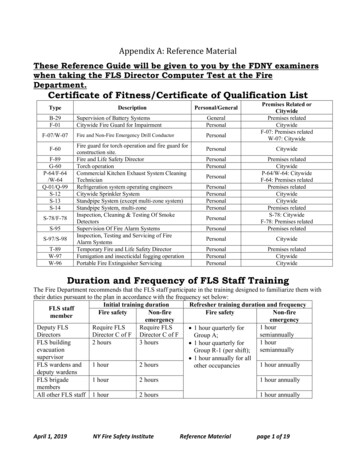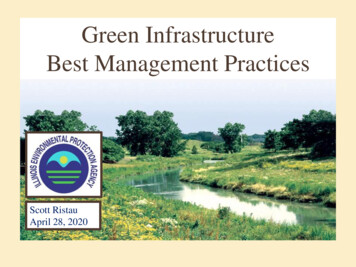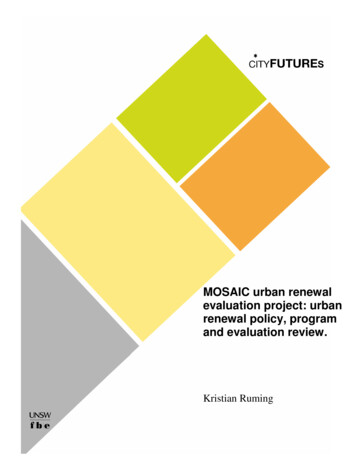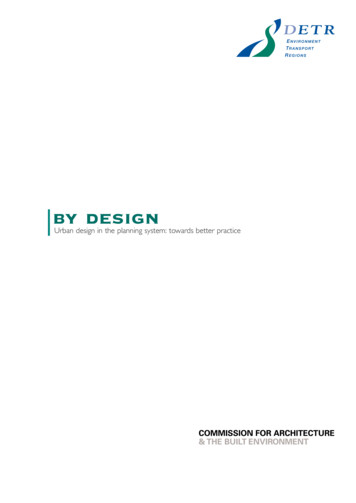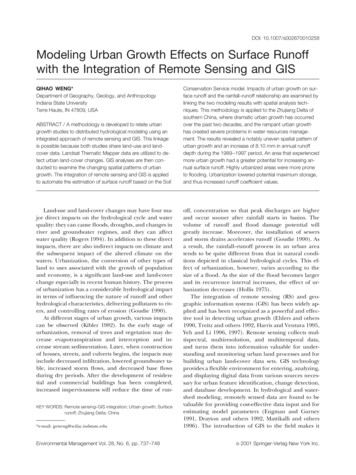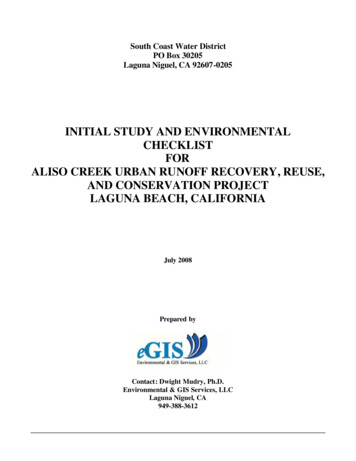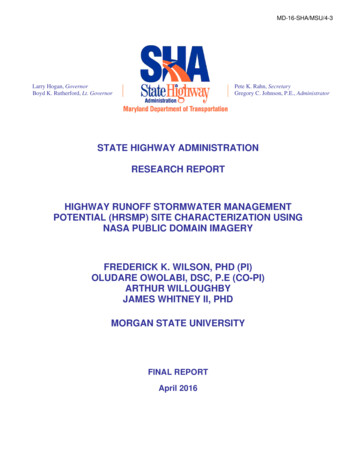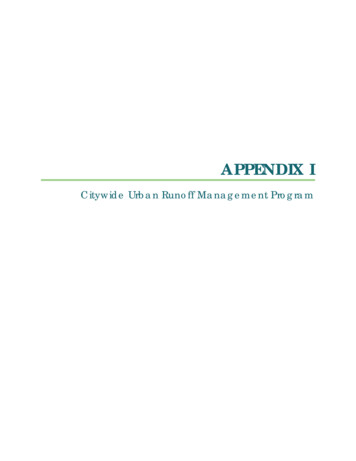
Transcription
APPENDIX ICitywide Urban Runoff Management Program
City of Huntington BeachCitywide Urban Runoff Management PlanJanuary 2005 - Section 3 Updated May 2015
ContentsSection 11.11.21.31.41.5Executive Summary . 1-1Background . 1-1Plan Development and Objectives . 1-3Water Quality Element . 1-61.3.1Citywide Source Control Programs . 1-121.3.2Program for New Development/ SignificantRedevelopment . 1-131.3.3Water Quality Planning Area-Based Programs . 1-131.3.4Program Implementation . 1-141.3.5Monitoring and Program Assessment. 1-141.3.6Responsibilities . 1-15Drainage Element . 1-15Program Costs and Funding . 1-171.5.1Program Costs . 1-171.5.2Funding . 1-18Section 22.12.2General Background . 2-1Urban Runoff Overview . 2-2Existing Drainage System Overview . 2-3Section 33.1Water Quality Element . 3-1Water Quality Setting . 3-13.1.1Runoff Quantity . 3-13.1.2Runoff Quality Monitoring . 3-33.1.2.1Urban Dry Weather Runoff Monitoring . 3-63.1.2.2Water Quality Monitoring Program Modifications. 3-73.1.3Regulatory Framework . 3-103.1.3.1Regulatory Requirements for Construction. 3-133.1.3.2TMDLS . 3-14Plan Components . 3-153.2.1Citywide Source Control Programs . 3-163.2.1.1Legal Authority. 3-173.2.1.2Municipal Activities . 3-183.2.1.3Public Education/Participation. 3-223.2.1.4Construction . 3-243.2.1.5Existing Development. 3-253.2.1.6Illicit Discharges/Illicit Connections . 3-303.2.2Program for New Development/SignificantRedevelopment . 3-333.2.2.1General Plan and Local Coastal Program Assessment . 3-343.2.2.2CEQA Environmental Review Process . 3-353.2.2.3Development Project Review, Approval and Permitting . 3-363.2.2.3.1 Standard Conditions of Approval. 3-393.2i
Contents(continued)3.2.2.23.33.43.53.6Section 44.14.2Specific Major Development/RedevelopmentOpportunities . 3-493.2.3Water Quality Planning Area-Based Programs . 3-493.2.3.1Santa Ana River Planning Area . 3-593.2.3.2Talbert Channel Planning Area . 3-593.2.3.3Coastal Planning Area . 3-623.2.3.4Bolsa Chica Wetlands Planning Area . 3-623.2.3.5Slater Channel Planning Area . 3-633.2.3.6East Garden Grove Wintersburg Channel Planning Area. 3-633.2.3.7Bolsa Chica Channel Planning Area . 3-633.2.3.8Harbor Area . 3-643.2.3.9Additional Citywide Opportunities . 3-64Program Phasing . 3-653.3.1Phasing Criteria and Categories . 3-653.3.1.1Ability to Achieve Water Quality Goals . 3-653.3.1.2Probability of Implementation . 3-663.3.2Phasing Categories . 3-673.3.3Phasing of Program Elements. 3-67Program Implementation . 3-743.4.1Policy and Ordinance Development. 3-743.4.2Monitoring and Program Assessment. 3-743.4.2.1Water Quality Element Implementation Assessment . 3-753.4.2.2NPDES Required Monitoring and Reporting. 3-753.4.2.3BMP Effectiveness Monitoring . 3-753.4.2.4Water Quality Monitoring. 3-763.4.2.5Information Management Using GIS . 3-763.4.2.6Additional Opportunities . 3-77Costs and Funding . 3-813.5.1Costs . 3-813.5.2Funding . 3-89Responsibilities . 3-90Drainage Element. 4-1Introduction . 4-14.1.1Purpose of Master Plan of Drainage . 4-14.1.2Characteristics of the Watershed. 4-14.1.2.1Sub-drainage Regions . 4-14.1.3Drainage Master Plan Methodology. 4-5Existing Facilities . 4-54.2.1Existing City Facilities . 4-54.2.2County of Orange Drainage Facilities . 4-54.2.3Other Public Agency Facilities . 4-74.2.4Soil Classifications . 4-74.2.5Land Use and Zoning . 4-94.2.6Data Capture . 4-9ii
Contents(continued)4.34.4Hydrologic Modeling . 4-94.3.1Hydrologic Model Development . 4-94.3.1.1Introduction. 4-94.3.1.2Development of the New MPD Analysis andImprovements . 4-124.3.1.3Computer Modeling Assumptions . 4-154.3.1.3.1 Streetflow Drainage Strategies . 4-154.3.1.3.2 Hydrologic/Hydraulic Modeling Assumptions. 4-154.3.1.3.3 Data Base Attribute Approximations . 4-194.3.1.3.4 Storage Element Boundary Conditions . 4-194.3.1.3.5 Street Element Topographic Grade Regulator . 4-204.3.1.3.6 Candidate Storage Elements . 4-204.3.1.3.7 Watershed Cascading Flow Effects . 4-224.3.1.3.8 Hydraulic Boundary Conditions . 4-224.3.1.3.9 Computer Modeling Algorithms . 4-224.3.1.3.10 Existing System Element Capacity Analysis and NewSystem Element Sizing Analysis . 4-224.3.1.3.11 Bifurcation Element Analysis . 4-264.3.1.3.12 Equivalent Pipe Element Analysis . 4-284.3.1.3.13 Pump Stations . 4-294.3.2Stormwater Information Management System and HydrologicAnalysis . 4-294.3.2.1Primary Logic Paths . 4-294.3.2.2Databases . 4-294.3.2.3SIMS Linkages. 4-314.3.2.4Watershed Discretization . 4-314.3.2.5Polygon Processing – Subarea Data . 4-344.3.2.6Unit Hydrograph Method Parameters . 4-344.3.2.7Link Information . 4-374.3.2.8GIS Data Forms – Summary. 4-374.3.2.9Getting Ready for Network Model Development –GIS Data Diagnostics . 4-404.3.2.10 Network Model Node Numbering Convention . 4-40Capacity Analysis . 4-434.4.1Conduit Capacity. 4-434.4.1.1Hydraulic Grade Line Assumptions. 4-434.4.1.2Existing System Flow Capacity Estimation: HGLEnvelopes. 4-444.4.1.3Existing System Flow Capacity Estimation: MinimumFriction Slopes . 4-444.4.1.4Existing System Flow Capacity Estimation: BalancedHGL . 4-444.4.2Upgrade Target Analysis . 4-444.4.2.1Multiple Return Frequency Hydrology Model Results . 4-44iii
Contents(continued)4.54.4.2.2Multiple Return Frequency Upgrade Target Analysis . 4-494.4.2.3Telescoping Analysis . 4-514.4.3Summary of Modeling Results . 4-51System Improvements . 4-554.5.1Introduction. 4-554.5.2Cost Opinion Basis for Improvements . 4-554.5.2.1Unit Cost Opinions for Reinforced Concrete Pipe. 4-564.5.2.2Unit Cost Opinions for Reinforced Concrete BoxCulverts . 4-584.5.2.3Unit Cost Opinions for Open Channels and Other SystemImprovements . 4-594.5.3System Upgrades Summary . 4-59AppendicesAppendix A City of Huntington Beach Urban Dry Weather Runoff MonitoringTechnical MemorandumAppendix B Water Quality Standards ExcerptsAppendix C Drainage Mapsiv
Contents(continued)List of FiguresFigure 1-1Figure 1-2Figure 1-3Figure 2-1Figure 2-2Figure 3-1Figure 3-2Figure 3-3aFigure 3-3bFigure 3-3cFigure 3-4Figure 3-5Figure 3-6Figure 3-7Figure 3-7.1Figure 3-7.2Figure 3-7.3Figure 3-7.4Figure 3-7.5Figure 3-7.6Figure 3.7.7Figure 3.7-8Figure 3-8Figure 3-9Figure 4-1Figure 4-2Figure 4-3Figure 4-4Figure 4-5Figure 4-6Figure 4-7Figure 4-8Figure 4-9Figure 4-10Figure 4-11Figure 4-12Figure 4-13Figure 4-14Figure 4-15Citywide Urban Runoff Management . 1-4Water Quality Element . 1-6Water Quality Program. 1-7Regional Watershed Map . 2-4Santa Ana River Watershed . 2-5Estimated Average Annual Flows, acre-ft/yr . 3-2Peak Instantaneous Flows, cfs. 3-3Sampling Locations . 3-8Dicharge at Sampling Locations . 3-9Regulatory Framework . 3-13Directly Connected Impervious Area . 3-42Zero Discharge Area Usage. 3-45Impervious Parking Lot vs. Parking Lot with Some PerviousSurfaces . 3-46Water Quality Planning Area – Index Sheet . 3-50Bolsa Chica Channel Planning Area . 3-51Harbor Planning Area . 3-52Wintersburg Channel Planning Area . 3-53Slater Channel Planning Area . 3-54Bolsa Chica Wetlands Planning Area . 3-55Coastal Planning Area. 3-56Talbert Channel Planning Area . 3-57Santa Ana River Planning Area . 3-58BMP Evaluation Site for Huntington Beach Bartlett Park . 3-61Areas of Responsibilities. 3-91Watershed Bounary Map . 4-2Modeling Drainage Sub-Regions for the Huntington BeachWatershed . 4-3County of Orange Drainage Facilities . 4-6Hydrologic Soil Classification. 4-8Hydrologic Land Use Impervious Factors . 4-11Selected Arterial Highways . 4-16Typical Street Sections . 4-17Storage Candidate Locations . 4-21Interface Management Screen . 4-30GIS Database Development. 4-32GIS Hydrologic Model . 4-33Hydrologic Layer Development . 4-35Integrated Rational Method Unit Hydrograph Modeling . 4-36Hydrologic Modeling Processes . 4-38GIS Entry . 4-39v
Contents(continued)Figure 4-16Figure 4-17Figure 4-18Figure 4-19Figure 4-20Figure 4-21Figure 4-22Diagnostic Flowchart . 4-41Storm Drain System Sizing: HGL Envelopes. 4-45Storm Drain System Sizing: Minimum Flow Velocity . 4-46Storm Drain System Sizing: HGL Gradient Search . 4-47Regulatory Return Frequency Hydrology Model Results . 4-48Flood Control System Analysis . 4-50System Element Telescoping Analysis . 4-52List of TablesTable 1-1 Summary of Water Quality Element Programs . 1-8Table 2-1 City of Huntington Beach Water Quality Planning Areas . 2-6Table 3-1 OCSD Water Quality Monitoring Sampling. 3-6Table 3-2 Update History of the NPDES Permits . 3-10Table 3-3 Beneficial Uses of Project Drainages . 3-12Table 3-4 2010 California 303(d) and TMDL Priority . 3-15Table 3-5 Summary of Citywide Source Control Program Elements. 3-17Table 3-5.1 Potential Pollutants from CIA/HOA Activities . 3-28Table 3-6 Summary of New Development and Significant RedevelopmentProgram Elements . 3-34Table 3-7 Site Design and Landscaping Techniques . 3-47Table 3-8 Factors Used for Phasing Program Elements . 3-67Table 3-9 Water Quality Program Element Phasing Citywide Source ControlPrograms . 3-68Table 3-10 Water Quality Program Element Phasing Program for NewDevelopment/Significant Redevelopment . 3-69Table 3-11 Water Quality Program Element Phasing Water Quality Planning AreaBased Program . 3-70Table 3-12 Policy and Ordinance Development . 3-74Table 3.4.2 Potential Water Quality Projects. 3-78Table 3-13 Huntington Beach Water Quality BMP Opportunities Estimated Costs. 3-82Table 3-14 Costs and Resources for Program Elements . 3-83Table 4-1 Modeling Assumptions . 4-18Table 4-2 Data Base Attribute Approximations . 4-19Table 4-3 Storage Element Values . 4-20Table 4-3 Storage Element Values . 4-20Table 4-4 Hydraulic Boundary Conditions . 4-23Table 4-5 Bifurcation Systems . 4-26Table 4-6 Equivalent Pipe Elements . 4-29Table 4-7 Storm Drain Reinforced Concrete Pipe Unit Cost Opinion . 4-56Table 4-8 Unit Cost Opinion for RCB Culvert Construction Costs . 4-58Table 4-10 Geographical Summary . 4-62vi
Section 1City of Huntington BeachCitywide Urban Runoff Management PlanDrainage Area Management PlanSection 1Executive Summary1.1BackgroundThe City of Huntington Beach (City) is approximately 28.2 square miles of land and islocated adjacent to the Pacific Ocean within a heavily urbanized region of OrangeCounty, California. Bordering cities include Seal Beach, Westminster, Fountain Valley,Newport Beach, Costa Mesa, and a portion of unincorporated Orange County. Froma water quality planning context, the northern portion of the county and the entireCity reside within what is broadly referred to as the Lower Santa Ana River Basinunder the Water Quality Control Plan (Basin Plan) adopted by the California RegionalWater Quality Control Board, Santa Ana Region (SARWQCB). The drainage areawithin the Lower Santa Ana River Basin and Orange County contains approximately2.9 million residents, occupying an area of approximately 789 square miles (includingunincorporated areas and the limits of 34 cities, 26 of which are within theSARWQCB’s jurisdiction). Section 2 of the Basin Plan presents a brief backgroundsummary of urban runoff characteristics, the existing drainage system and watershedsetting.Storm water discharges from the urbanized areas in Orange County consist mainly ofsurface runoff from residential, commercial, and industrial developments. In addition,there are storm water discharges from agricultural land uses, including farming andanimal operations. Discharges from various areas within the City drain directly orindirectly into urban streams, lakes, bays, wetlands, estuaries, Huntington Harbour,and the Pacific Ocean. The City owns, operates, and maintains a storm drainagesystem for the purpose of conveying storm runoff so as to reduce or eliminateflooding under peak storm flow conditions. The storm drainage system begins withthe streets and roads, and includes inlets, storm drains, open channels, pump stations,detention basins, and other appurtenances. The system carries both dry and wetweather urban runoff and the pollutants associated with runoff from urban land useand activities.Several major channels owned and maintained by Orange County are also locatedwithin the City. These channels receive runoff from areas within the City as well assubstantial drainage areas in other upstream jurisdictions. It is estimated that runofffrom the City makes up about 35-40 percent of the total dry and wet weather flows inthe channels.1-1
Section 1City of Huntington BeachCitywide Urban Runoff Management PlanAs urban runoff (both dry and wet weather) discharges into the urban waterways,lakes, bays, Huntington Harbour, and the Pacific Ocean, it can be a source ofpollution. Extensive studies have indicated that sources such as possible exfiltrationfrom sewers are not a contributor to high bacterial counts in coastal waters.Additional studies conducted by the City and others are continuing to identifysources and work toward the specific objective of minimizing posting and closure ofcoastal waters.Over the past few years, the general public, the City Council, and staff have becomeincreasingly aware of environmental concerns and the importance of water qualityand the potential impacts from urban runoff within the City. Because clean water isessential to support human and aquatic life, and recreation and tourism are majorelements of the fabric and economy of the City, impairments to the local coastalwaters have a major detrimental impact on the City. At the same time, regulatoryrequirements are increasingly focusing on non-point source pollution impacts from awide variety of pollutants, particularly in urban runoff from developed areasdischarged from municipal storm drainage systems and industrial and constructionsites.The Citywide Urban Runoff Management Plan (CURMP) provides a broadframework for managing the quantity and quality of all urban runoff 1 that reachesreceiving waters from the land surfaces and through the storm drain system withinthe City. The Water Quality Element of the CURMP focuses primarily on managingrunoff quality, while the Drainage Element addresses flood hazards andinconveniences. The CURMP identifies potential common solutions that can addressboth water quality and quantity concerns.This update provides a detailed discussion of runoff quantity and quality for theWater Quality Element (Section 3) designed to meet or exceed the followingrequirements of the National Pollutant Discharge and Elimination System (NPDES)Permit for the Water Quality Element of the CURMP: Regulatory environmental updates. Revisions to citywide source control programs.1The term urban runoff as used in this Plan is defined as all flows in the storm drain system under bothdry and wet weather conditions. In this context, the drainage system includes yard drains, swales,streets, curbs and gutters, storm drain inlets, catch basins, underground pipes, pump stations, openchannels, lakes, detention basins, storm drain outfalls, and other designated water quality features suchas vegetated swales, ravines, vegetated filter areas and wetlands.1-2
Section 1City of Huntington BeachCitywide Urban Runoff Management Plan Revisions for major projects, and applicable NPDES requirements for thosedevelopments. Revisions to phasing/program implementation/monitoring of programelements as necessary. Revisions to funding opportunities.No updates to the CURMP beyond Section 3 and associated cost estimates for waterquality projects have been completed at this time.A summary of the hydrologic modeling and a detailed description of the drainagesystem capacity analysis and system improvement plan are found in the DrainageElement in Section 4.1.2Plan Development and ObjectivesRecognizing the importance of managing both the quantity and quality of runoffconveyed by the storm drain system, the City adopted an integrated CURMP in 2005.The CURMP contains the Water Quality Element and Drainage Element to takeadvantage of information developed under both efforts and identifies integratedsolutions that address both water quality and flood hazard protection goals. Figure 11 illustrates how the CURMP includes both the Water Quality Element and DrainageElement. Section 1.3 provides a summary of the Water Quality Element, while Section1.4 summarizes the Drainage Element.1-3
Section 1City of Huntington BeachCitywide Urban Runoff Management PlanFigure 1-1Citywide Urban Runoff Management PlanThe 2005 CURMP was developed through the cooperative efforts of City Staff, led bythe Public Works Department, a consultant team, and a Focus Group that consisted ofrepresentatives from the City Council, City Staff, community and business leaders,and environmental interest groups. The Focus Group members included:City CouncilRalph Bauer (former)Debbie Cook (former)Shirley Dettloff (former)Cathy Green (former)Dave Sullivan (former)1-4
Section 1City of Huntington BeachCitywide Urban Runoff Management PlanCity StaffTodd Broussard, Principal Civil EngineerSteve Krieger, Civil Engineering Assistant (former)Geraldine Lucas, Environmental Engineer (former)David Webb, City Engineer (former)Mary Beth Broeren, Principal Planner (former)Community MembersGarry Brown, Orange County CoastkeeperRichard Harlow, Public Works Commission (former)Victor Leipzig, Orange Coast WatchGeorge Mason, Public Works Commission (former)Through the efforts of the Focus Group and City’s Team, the following objectiveswere developed for the CURMP.The CURMP will guide the City’s Storm Water Quality program to improve thequality of local coastal waters, harbors, lakes and other urban waterways in order to: Comply with state and federal regulations; Protect public health and safety; Protect and enhance the beneficial uses such as recreation, aesthetics, economics,and habitat value of the local aquatic systems; Reduce pollutan
Table 3-13 Huntington Beach Water Quality BMP Opportunities Estimated Costs . 3-82 . City of Huntington Beach Citywide Urban Runoff Management Plan 1-1 Section 1 Executive Summary . 1.1 Background . Citywide Urban Runoff Management Plan

